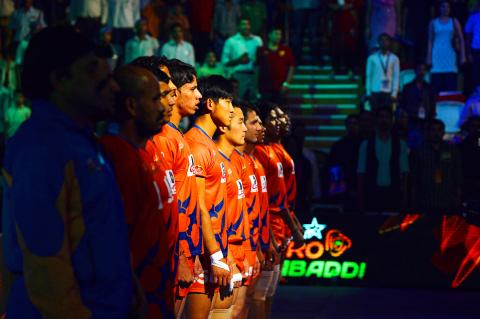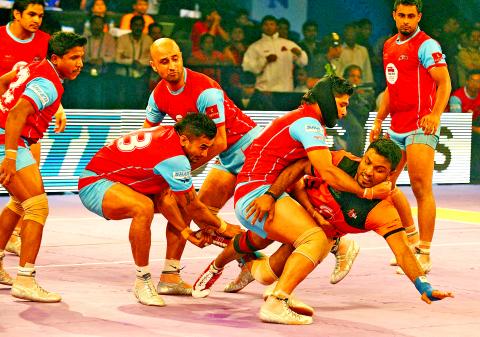An ancient Indian sport that looks like a mixture of tag, dodgeball and wrestling has barreled back into the Indian national consciousness to become one of the country’s most popular sports, trailing only cricket.
Once a favorite kids’ game that was largely forgotten in adulthood, kabaddi has had a surge of serious money and Bollywood glamor since the launch of the Pro-Kabaddi League in July.
“This is the Indian soul game,’’ said Prashant Khandekar, a chef, minutes after watching the first league final in Mumbai last month.

Photo: AFP/ Chandan Khanna
LARGE AUDIENCE
Since the league’s launch, 396 million viewers have watched the live televised matches according to TAM Media Research, which monitors viewing figures nationally — more than double the number of Indians who watched this year’s soccer World Cup.
In the space of a month, kabaddi became India’s second most-watched sport, leap-frogging field hockey to trail only the obsessively-followed Indian Premier League in cricket.

Photo: AFP/ Punit Paranjpe
The 12 teams touring five cities across India attracted sell-out crowds, and 22 million tuned in to the semifinals.
Versions of kabaddi have been played in India for thousands of years, mostly on dusty patches of land. The pro league has launched a version supported by lasers, glitter explosions and techno music. With players in slick uniforms and hawkers throwing out Kabaddi T-shirts, it unabashedly attempts to recreate the atmosphere of games in the NBA or Major League Baseball. And it seems Indians like it.
“It’s our own sport,” said Ronnie Screwvala, a kabaddi commentator who founded the league. “But it’s not buried under some ancient mound. It’s a new, modern international sport.”
On paper, kabaddi would seem a peculiar game to be played professionally. Essentially, it resembles Red Rover: Two teams of seven score points through “raids,” where a player darts into the opponents’ half and tries to cross a line on the far side of the court.
The opposing team’s job is to stop him. Defenders can tackle the raider anytime he’s moving, resulting in spectacular jumping dodges as the attacking player tries to fly over the typically wrestler-sized opponents looking to slam him to the ground.
The game’s most unusual feature also lends the sport its name: Whenever attacking, a player must chant the word “kabaddi” repeatedly without drawing breath. If he stops before returning to his own half, he forfeits any points gained in the attack.
The word “kabaddi” has no obvious meaning. One fan’s explanation summed it up well enough: “Kabaddi is called kabaddi because of the kabaddi.”
Alternative words can be chanted in place of “kabaddi,” including “huta huta,” although the Pro-Kabaddi League has chosen to prescribe the former. The act of repeating the word is said to be connected to the yoga practice of controlled breathing.
BIG LEAGUE, BIG BUCKS
Kabaddi has always been popular in India — Mumbai alone has 200 amateur clubs — but Indians never seemed to consider it worthy of major league attention. Although played at the Asian Games, where India has won every kabaddi competition since it was introduced and is again the favorite to win in Incheon, South Korea, there has never been a commercial outlet for it.
“The sport had gone, if I can use the term, underground,” said Screwvala. “In fact, there was a fair amount of prejudice, where a lot of people thought, `Yes, it’s our game but it’s probably more of a rural game than anything else.’”
Screwvala has built his league from scratch, inviting tycoons from India’s business and showbiz elites to found teams. Squads were then created from an auction of 96 players, ranked by the national kabaddi federation which has formally endorsed the league.
Like India’s US$3 billion IPL cricket competition before it, people are scenting money around kabaddi, conscious of the country’s huge audiences.
Each team owner has paid around US$10 million for franchising rights, with initial investments coming to roughly US$50 to 60 million each. Although still minuscule by cricketing standards, player salaries have rocketed, making in a month in the league almost double what they’d ordinarily make in a year. Several teams are already founding kabaddi academies.
An international league has also launched with games to be held in Britain, the US and Dubai. Separate from the Pro-Kabaddi League, investments in the World Kabaddi League are similarly large, with player salaries even higher at 10.5 million rupees or around US$170,000.
Founded almost simultaneously, the leagues are competing for audiences.
BOLLYWOOD INVOLVEMENT
Promoters are also relying on some of India’s more famous entertainment exports to glamorize the game. The owner of the Jaipur Pink Panthers, the Pro-League’s first champion, is Abhishek Bacchan, one of Bollywood’s highest-paid actors. His involvement ensured a large Bollywood star presence at the final. Two of the international league’s teams are also owned by Bollywood actors.
For the players, it’s an entry into another world. Many are from rural villages, where kabaddi has its strongest following. Overnight, these players have gone from small competitions in community centers to being national TV stars.
“Everything has changed, I never thought that this would happen to me,” said Rishank Devadiga, 22, who until recently worked in a hotel and now plays for Mumbai’s UMumba team.
“I come out of my house, people say ‘This is Rishank Devadiga!’ They come to me, take photos.”
Devadiga was paid 520,000 rupees or US$8,400 for the month, almost double his annual salary. Many players are paid more.
The demands of the big time have already had an effect on the sport. To make the game more TV-friendly, attacks have been limited to 30 seconds. Since your average professional can say “kabaddi” for a minute, the game’s titular rule has been somewhat diluted.
Instead, “kabaddi, kabaddi, kabaddi” plays deafeningly from speakers during attacks, followed by “Yes, kabaddi? No, kabaddi” as the clock runs down.
Fans don’t seem to mind.
“We used to play this game in our childhood,” said Deepteesh D. Singh, 27, after watching his team, Jaipur, win. “And it has come to this level. It’s great.”

Wooden houses wedged between concrete, crumbling brick facades with roofs gaping to the sky, and tiled art deco buildings down narrow alleyways: Taichung Central District’s (中區) aging architecture reveals both the allure and reality of the old downtown. From Indigenous settlement to capital under Qing Dynasty rule through to Japanese colonization, Taichung’s Central District holds a long and layered history. The bygone beauty of its streets once earned it the nickname “Little Kyoto.” Since the late eighties, however, the shifting of economic and government centers westward signaled a gradual decline in the area’s evolving fortunes. With the regeneration of the once

Even by the standards of Ukraine’s International Legion, which comprises volunteers from over 55 countries, Han has an unusual backstory. Born in Taichung, he grew up in Costa Rica — then one of Taiwan’s diplomatic allies — where a relative worked for the embassy. After attending an American international high school in San Jose, Costa Rica’s capital, Han — who prefers to use only his given name for OPSEC (operations security) reasons — moved to the US in his teens. He attended Penn State University before returning to Taiwan to work in the semiconductor industry in Kaohsiung, where he

On May 2, Chinese Nationalist Party (KMT) Chairman Eric Chu (朱立倫), at a meeting in support of Taipei city councilors at party headquarters, compared President William Lai (賴清德) to Hitler. Chu claimed that unlike any other democracy worldwide in history, no other leader was rooting out opposing parties like Lai and the Democratic Progressive Party (DPP). That his statements are wildly inaccurate was not the point. It was a rallying cry, not a history lesson. This was intentional to provoke the international diplomatic community into a response, which was promptly provided. Both the German and Israeli offices issued statements on Facebook

Perched on Thailand’s border with Myanmar, Arunothai is a dusty crossroads town, a nowheresville that could be the setting of some Southeast Asian spaghetti Western. Its main street is the final, dead-end section of the two-lane highway from Chiang Mai, Thailand’s second largest city 120kms south, and the heart of the kingdom’s mountainous north. At the town boundary, a Chinese-style arch capped with dragons also bears Thai script declaring fealty to Bangkok’s royal family: “Long live the King!” Further on, Chinese lanterns line the main street, and on the hillsides, courtyard homes sit among warrens of narrow, winding alleyways and